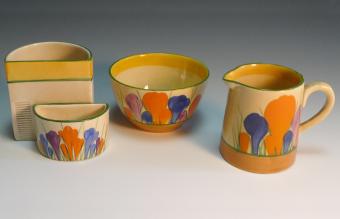
Although you might not know her name, you've certainly seen the influence that Clarice Cliff had on bringing a modernist flair to pottery and dinnerware between the 1930s-1960s. Many marveled at her 'rags-to-riches' story, but it was truly her unique artistic vision that cemented her in history. Take a look at some of her most popular pieces and learn about how this simple potter became a legend.
The Life and Times of Clarice Cliff
Clarice Cliff was a born Englishwoman, who called the pottery factories and workshops of the Staffordshire district home. Having come into the world in 1899 and already becoming a dedicated worker at the A.J. Wilkinson pottery studio by 1916, Cliff was surpassing most women of her age. However, she couldn't settle for working in production and after some time studying at an arts school, she was given a studio space in Newport Pottery, where she took unsold white ceramics and painted over them with colorful, Art Deco inspired scenes. These were first released in 1927, and by 1930 there was already an official line of her pottery for sale. She was a mainstay of the contemporary pottery market, and her thriving business could only be stunted by the destruction of World War II. Her work came back into production in the post-war period but ceased after her death in 1972. Yet, her acclaim only grew and the examples of her work reached higher and higher bids at auction, with an American collector bidding about £15,000 on a small group of Cliff's rare human figurines in 2018.
How to Identify a Clarice Cliff Original
Unfortunately, experts believe it's rather difficult for a novice to know if they have an early or rare piece from Cliff's workshop. This is because the marks weren't always stamped in the same fashion, and since much of her early pottery was completed on already fired ceramics, some ink authentication stamps have long since faded away. Thus, you'll want to confirm with an expert in Cliff's work to ensure that a piece is actually hers, which you can easily do by reaching out to the Clarice Cliff Museum and submitting a valuation form. Similarly, her work has an incredible amount of visual range, meaning she didn't stick to one particular style or color palette, which just complicates authentication even further.

Clarice Cliff's Work
Cliff was duly inspired by the zeitgeist Art Deco designers of the period and the fringe Modernist artists of the Cubist and De Stijl movements. This culminated in a one-of-a-kind body of work, which includes her most popular series: transferware dinner sets, her Bizarre designs, and the Chintz pattern.
Bizarre Series (Teapots, Coffee Sets, Dinneware)
This early series ran throughout the late 1920s and 1930s, and it really showcased her interest in bringing Cubism and Modernist artistic theory into the average home. Her teapots in particular, with their triangular handles and somewhat disproportioned angles, have become one of the most identifiable pieces from her catalog. She played with the traditions associated with dinnerware by creating odd shapes, lines, color palettes and motifs. However, this unusual design greatly appealed to people who were tired of the sleek, coldness of Art Deco's chrome and geometry. Generally, these are the pieces modern collectors are most interested in owning, and they've regularly sold between $1,000-$6,000. For example, a "House and Bridge" tea set sold in 2006 for $4,250, and a "Farm House" lotus jug from 1930 sold for $2,400 in 2020.

Royal Staffordshire Transferware
In an attempt to create a more economical line of dinnerware, Cliff partnered with Royal Staffordshire and designed a series of transferware in a variety of patterns and colors. This is the best place to start for beginner collectors because they're the Cliff that you're most likely to find on display in an antique store. These plates, cups, and pitchers were made using an ink-transfer method and were stamped on the bottom with both the Royal Staffordshire logo and Clarice Cliff's name. Individual pieces from the 1930s, like this 1930s Biarritz Paradise Plate, are still going to cost a few hundred dollars depending on their pattern and condition, while whole mid-century sets will cost you about the same. Here are a few of the different patterns these plate sets came in.
- Tonquin
- Rural Scenes
- Peaceful Summer
- Charlotte
- The Biarittz Paradise

Chintz Pattern
Created in Bizarre style with bright, often contrasting, colors, pieces which display the Chintz Pattern are rather collectible. This pattern showcases a modern take on the floral chintz cotton patterns that could be found across England at the time. These large cell-like flowers appear in a variety of colors, most often in blues, oranges, reds, and yellows. Although not as pricey as some of her Bizarre teapots, porcelain that comes in her Chintz pattern can be worth a pretty penny. For example, one sizable blue chintz jug is listed for $160 in one auction and a 1933 blue chintz biscuit barrel is listed for $900 in another. However, if the chintz isn't for you, there are many other floral-inspired patterns (gardenia, crocus, pansy, and so on) that she produced which you can find.

Add a Clarice Cliff to Your Collection
According to the Antiques Trade Gazette, right now is the perfect time to buy a Clarice Cliff as prices are incredibly low in relation to those from previous years, and with a dip in the market comes a renewed interest on the horizon. So cliff dive into this incredible female artist's work and add one of her pieces to your own collection.







